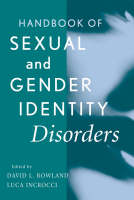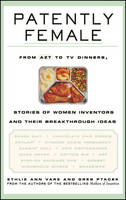Our Voices
 -15%
portes grátis
-15%
portes grátis
Our Voices
Psychology of Women
Rider, Elizabeth A.
John Wiley & Sons Inc
09/2005
640
Mole
Inglês
9780471478799
15 a 20 dias
1186
Descrição não disponível.
Diversity Topics. Preface.
About the Author.
Chapter 1. Foundations for a Psychology of Women.
All the Women in the World.
How They Differ.
What They Share.
Real Life: Life in Rural Africa.
Historical Overview.
Early Women's Movements.
Women's Movements Today.
Feminism.
Women in Psychology.
Psychology Views Women.
Women's Contributions to Psychology.
Current Status of Women in Psychology.
Women's Psychology: A Unique Field.
Psychology of Women and the Study of Gender.
Will the Field Remain Relevant?
Points to Keep in Mind.
Meaning Is Relative.
Gender and Context Are Inseparable.
Biases Are Everywhere.
Individuals Vary More Than Groups.
There is Much Variability Within Groups.
There's an Exception to Every Rule.
Socialization and Culture Are Crucial to Gender.
Conclusions.
Chapter Summary.
Key Terms.
Suggested Readings.
Web Resources.
Chapter 2. Studying Women and Gender.
Traditional Research Methods.
Experimental Methods.
Quasi-Experimental Methods.
Correlational Methods.
Evaluating Traditional Methods.
Nonsexist Research Methods.
Feminist Methods.
Concerns with Traditional Research.
Featured Study: Feminist Study of Menopause.
Organizing Themes.
Integrating the Approaches.
Research on Gender Differences.
Are Males and Females Really So Different?
How Are Differences Detected?
Commentary: The Practical Significance of Gender Differences.
Where Do We Stand on Comparative Gender Research?
What Do Gender Differences Mean?
Conclusions.
Chapter Summary.
Key Terms.
Suggested Readings.
Web Resources.
Chapter 3. Explaining Gender.
Psychodynamic Theories.
Freud and Biological Identity
Evaluation.
Commentary: Phyllis Freud Turns the Tables.
Post- and Neo-Freudians.
Social-Learning and Social-cognitive Theory.
Reinforcement and Imitation.
Evaluation.
Cognitive Theories.
Cognitive-Developmental Theory.
Featured Study: Gender Awareness in Children.
Gender Schema Theory.
Social-Role Theory.
Structured Social Roles.
Evaluation.
Feminist Perspectives.
Gender as Social Construction.
Evaluation.
Feminist Perspectives.
Gender and Social Construction.
Critique: How Well Do the Theories Do?
Conclusions.
Chapter Summary.
Key Terms.
Suggested Readings.
Web Resources.
Chapter 4. How Biology Affects Gender.
Genetics.
Gender Determination.
Genetic Complications.
Sex Hormones.
Gender Categories.
Prenatal Development.
Consequences of Prenatal Hormonal Conditions.
Hormones and Development.
Hormones and Behavior.
Commentary: How Many Sexes are There?
The Brain.
Hormonal Influences.
Hemispheric Lateralization.
Sex and Brain Size.
Biological Theories of Gender.
Biosocial Theory.
Featured Study: Mistakes of Gender and Gender Identity.
Evolutionary Psychology.
Conclusions.
Chapter Summary.
Key Terms.
Suggested Readings.
Web Resources.
Chapter 5. Socialization: Assigning Roles to Women.
Family Socialization.
Do You Want a Boy or a Girl?
Parents and Babies.
Who Does What?
Girl's World, Boy's World.
Racial and Cultural Variations.
How Strong Is Parental Influence?
Gender Roles Across the Life Span.
Teachers and Schools.
Media.
Television.
Commentary: An African American Perspective of TV.
Featured Study: Gender Stereotypes in Disney Films.
Newspapers.
Magazines and Books.
Other Media.
Media Representations of the Female Body.
Commentary: What Do We Learn from Barbie?
Play and Sports.
Play Group Structure.
Athletic Organizations.
Conclusions.
Chapter Summary.
Key Terms.
Suggested Readings.
Web Resources.
Chapter 6. Communicating.
Do Women and Men use Language Differently?
Who Talks More?
Interrupting.
Intonation and Pitch.
Slang
Tentative Speech.
Homor.
Research Limitations.
Women, Men, and Language.
Featured Study: Culture, Gender, and Conversation.
Commentary: Guess What-Women Are Funny!
The Other Ways We Communicate.
Eye Gaze.
Touch.
Smiling.
Personal Space, Posture, and Appearance.
Women's "Intuition".
How Language Represents Women.
The Normative Male.
The Pejorative Woman.
Language and Thought.
Commentary: What's in a Name?
Gender-Inclusive Language.
Conclusions.
Chapter Summary.
Key Terms.
Suggested Readings.
Web Resources.
Chapter 7. Reasoning About the World.
Are Women Smarter Than Men?
Intelligence.
Memory.
The Cognitive Abilities of Women and Men.
Verbal Abilities.
Mathematical Abilities.
Spatial Abilities?
Commentary: Single-Sex Classes?
Explaining Gender Differences in Cognitive Abilities.
Achievement.
Motivation to Achieve.
Explaining the Successes and the Failures.
Featured Study: Are Girls "Helpless" When It Comes to Computers?
Self-Confidence.
Ethnic and Cultural Differences.
Reasoning Morally.
Kohlberg's Theory.
Gilligan's Response.
Conclusions.
Chapter Summary.
Key Terms.
Suggested Readings.
Web Resources.
Chapter 8. Work.
Overview.
Where Do Women Work?
What Do You Want to Be?
Traditional Careers.
Nontraditional Careers.
Eccles' Model of Occupational Choice.
Discrimination.
Hiring Practices.
Financial Inequities.
Featured Study: How Much Do You Think You Should Earn?
Comparable Worth.
Promotion Practices.
Affirmative Action.
Combining Employment with Family.
Women's Expectations.
Maternity Leave.
Real Life: I Want a Career and I Want a Family . . .
Housework.
Well-Being.
When a Woman Retires.
Earnings.
Adjustment.
Conclusions.
Chapter Summary.
Key Terms.
Suggested Readings.
Web Resources.
Chapter 9. Personality and Social Interactions.
Aspects of Personality.
Five-Factor Model.
Levinson's Life Structure.
Stone Center's Relational Theory.
Power and Behavior.
Aggression.
Assertiveness.
Competition.
Leadership.
Featured Study: Identity and Leadership in Cross-Cultural Contexts.
Prosocial Behaviors.
Who Empathizes?
Who Helps?
Who Nurtures?
Who is Swayed?
Other Components of Personality.
Self-esteem.
Emotions.
Friendship.
Women Who Are Friends.
Real Life: African American and White Lesbian Friendships.
Men and Women Can Be Friends.
Real Life: Guy Friends.
Conclusions.
Chapter Summary.
Key Terms.
Suggested Readings.
Web Resources.
Chapter 10. Relationships and Lifestyles.
Dating and Commitment.
Selecting a Partner.
Dating Scripts.
Commentary: Dating by "The Rules".
Marriage and Partnerships.
What's Love Got to do with it?
Racial Variations.
Is Marriage Satisfying.
Infidelity.
Living Together: Significant Others.
Divorce or Separation.
What Causes Divorce?
The Consequences for Women.
Featured Study: Racial Differences in Reaction and Coping with Separation and Divorce.
Having Children.
Why We Have Children.
What We Expect.
The Realities of Motherhood.
Variations on Child Rearing: Single, Minority, Lesbian Motherhood.
Parenthood Changes Marriage.
Real Life: The Motherhood Experience.
Childcare Issues.
Staying Single.
Why We Stay Single.
Its Disadvantages.
Its Advantages.
Lesbians.
Labels Confine Our Perceptions.
Stereotyping Lesbians.
Lesbians in Relationships.
Commentary: Same-Sex Marriages.
Conclusions.
Chapter Summary.
Key Terms.
Suggested Readings.
Web Resources.
Chapter 11. Health and Reproduction.
Toward a Health Care System for Women.
Gender Bias.
Racial Bias.
Overall Health and Fitness.
Weight.
Poor and Minority Women.
Problems Women Face.
Heart Disease Is Not Just for Men.
The Insidious Killer, Lung Cancer.
The Once Silent Epidemic, Breast Cancer.
Real Life: When Cancer Strikes.
Other "Female" Cancers.
The Menstrual Cycle.
Menarche and Puberty.
Commentary: If Men Could Menstruate.
"Female" Problems.
Pregnancy.
Fertility and Infertility.
How We Feel, How They Feel.
Real Life: Being Pregnant.
The Teenage Pregnancy Epidemic.
Childbirth.
The Stages of Labor.
Cesarean Delivery.
Postpartum Adjustment.
Abortion.
Psychological Reactions.
Menopause.
Physical Changes.
Psychological Reactions.
Conclusions.
Chapter Summary.
Key Terms.
Suggested Readings.
Web Resources.
Chapter 12. Sexuality.
Sexuality and Our Beliefs.
Conducting Research.
An Entrenched Double Standard.
Emerging Sexuality.
Infancy and Childhood.
Learning about Sex.
Adolescence.
Real Life: Sexual Experiences.
Explaining Sexual Behaviors: Script Theory.
Adult Sexuality.
Ethnic Variations.
The Middle Years and Beyond.
Lesbian Sexuality.
Biology or Culture?
Contraception.
Methods.
Real Life: Who Should Be Responsible for Contraception?
Use and Nonuse.
Featured Study: "When You Carry Condoms All the Boys Think You Want It" .
Sexual Problems.
Sexually Transmitted Diseases.
Sexual Dysfunctions.
Conclusions.
Chapter Summary.
Key Terms.
Suggested Readings.
Web Resources.
Chapter 13. Violence in Women's Lives.
Rape.
Just How Prevalent Is Rape?
Myths and Scripts.
Stranger Rape.
Commentary: The "Rape" of Mr. Smith.
Acquaintance and Date Rape.
Marital or Relationship Rape.
The Consequences.
Recovery.
Real Life: The Aftermath of Date Rape.
Real Life: Helping Someone Who Has Been Raped Heal.
Men Who Rape.
Preventing Rape.
Incest.
Childhood Sexual Abuse.
The Effects Last a Lifetime.
Violent Relationships.
The Victims.
The Abusers.
Social Conditions.
The Cycle of Abuse.
Why Do Some Women Stay?
Featured Study: Inner Strength of Abused Women.
Harassment.
Definition and Types.
At Work.
At School.
Among Peers.
The Effects of Harassment.
Conclusions.
Chapter Summary.
Key Terms.
Suggested Readings.
Web Resources.
Chapter 14. Mental Health.
Diagnosis.
What Constitutes "Good" Mental Health?
A New View of Mental Health.
Diagnostic Criteria.
Gender Bias.
Racial and Cultural Biases.
Depression: Beyond Sadness.
Diagnosis and Characteristics.
Explaining Gender Differences.
Real Life: The Beast.
Anxiety Disorders.
Agoraphobia and Panic Attacks.
Eating Disorders.
Anorexia.
Real Life: Wasted.
Bulimia.
Prognosis.
Substance Abuse.
Tobacco.
Alcohol and Other Drugs.
Therapy.
Traditional Approaches.
Nonsexist Therapy.
Feminist Therapy.
Racial and Cultural Issues.
Conclusions.
Chapter Summary.
Key Terms.
Suggested Readings.
Web Resources.
Chapter 15. Epilogue.
The Importance of Gender.
Common Themes.
Conclusions.
Suggested Readings.
References.
Name Index.
Subject Index.
Subject Index.
About the Author.
Chapter 1. Foundations for a Psychology of Women.
All the Women in the World.
How They Differ.
What They Share.
Real Life: Life in Rural Africa.
Historical Overview.
Early Women's Movements.
Women's Movements Today.
Feminism.
Women in Psychology.
Psychology Views Women.
Women's Contributions to Psychology.
Current Status of Women in Psychology.
Women's Psychology: A Unique Field.
Psychology of Women and the Study of Gender.
Will the Field Remain Relevant?
Points to Keep in Mind.
Meaning Is Relative.
Gender and Context Are Inseparable.
Biases Are Everywhere.
Individuals Vary More Than Groups.
There is Much Variability Within Groups.
There's an Exception to Every Rule.
Socialization and Culture Are Crucial to Gender.
Conclusions.
Chapter Summary.
Key Terms.
Suggested Readings.
Web Resources.
Chapter 2. Studying Women and Gender.
Traditional Research Methods.
Experimental Methods.
Quasi-Experimental Methods.
Correlational Methods.
Evaluating Traditional Methods.
Nonsexist Research Methods.
Feminist Methods.
Concerns with Traditional Research.
Featured Study: Feminist Study of Menopause.
Organizing Themes.
Integrating the Approaches.
Research on Gender Differences.
Are Males and Females Really So Different?
How Are Differences Detected?
Commentary: The Practical Significance of Gender Differences.
Where Do We Stand on Comparative Gender Research?
What Do Gender Differences Mean?
Conclusions.
Chapter Summary.
Key Terms.
Suggested Readings.
Web Resources.
Chapter 3. Explaining Gender.
Psychodynamic Theories.
Freud and Biological Identity
Evaluation.
Commentary: Phyllis Freud Turns the Tables.
Post- and Neo-Freudians.
Social-Learning and Social-cognitive Theory.
Reinforcement and Imitation.
Evaluation.
Cognitive Theories.
Cognitive-Developmental Theory.
Featured Study: Gender Awareness in Children.
Gender Schema Theory.
Social-Role Theory.
Structured Social Roles.
Evaluation.
Feminist Perspectives.
Gender as Social Construction.
Evaluation.
Feminist Perspectives.
Gender and Social Construction.
Critique: How Well Do the Theories Do?
Conclusions.
Chapter Summary.
Key Terms.
Suggested Readings.
Web Resources.
Chapter 4. How Biology Affects Gender.
Genetics.
Gender Determination.
Genetic Complications.
Sex Hormones.
Gender Categories.
Prenatal Development.
Consequences of Prenatal Hormonal Conditions.
Hormones and Development.
Hormones and Behavior.
Commentary: How Many Sexes are There?
The Brain.
Hormonal Influences.
Hemispheric Lateralization.
Sex and Brain Size.
Biological Theories of Gender.
Biosocial Theory.
Featured Study: Mistakes of Gender and Gender Identity.
Evolutionary Psychology.
Conclusions.
Chapter Summary.
Key Terms.
Suggested Readings.
Web Resources.
Chapter 5. Socialization: Assigning Roles to Women.
Family Socialization.
Do You Want a Boy or a Girl?
Parents and Babies.
Who Does What?
Girl's World, Boy's World.
Racial and Cultural Variations.
How Strong Is Parental Influence?
Gender Roles Across the Life Span.
Teachers and Schools.
Media.
Television.
Commentary: An African American Perspective of TV.
Featured Study: Gender Stereotypes in Disney Films.
Newspapers.
Magazines and Books.
Other Media.
Media Representations of the Female Body.
Commentary: What Do We Learn from Barbie?
Play and Sports.
Play Group Structure.
Athletic Organizations.
Conclusions.
Chapter Summary.
Key Terms.
Suggested Readings.
Web Resources.
Chapter 6. Communicating.
Do Women and Men use Language Differently?
Who Talks More?
Interrupting.
Intonation and Pitch.
Slang
Tentative Speech.
Homor.
Research Limitations.
Women, Men, and Language.
Featured Study: Culture, Gender, and Conversation.
Commentary: Guess What-Women Are Funny!
The Other Ways We Communicate.
Eye Gaze.
Touch.
Smiling.
Personal Space, Posture, and Appearance.
Women's "Intuition".
How Language Represents Women.
The Normative Male.
The Pejorative Woman.
Language and Thought.
Commentary: What's in a Name?
Gender-Inclusive Language.
Conclusions.
Chapter Summary.
Key Terms.
Suggested Readings.
Web Resources.
Chapter 7. Reasoning About the World.
Are Women Smarter Than Men?
Intelligence.
Memory.
The Cognitive Abilities of Women and Men.
Verbal Abilities.
Mathematical Abilities.
Spatial Abilities?
Commentary: Single-Sex Classes?
Explaining Gender Differences in Cognitive Abilities.
Achievement.
Motivation to Achieve.
Explaining the Successes and the Failures.
Featured Study: Are Girls "Helpless" When It Comes to Computers?
Self-Confidence.
Ethnic and Cultural Differences.
Reasoning Morally.
Kohlberg's Theory.
Gilligan's Response.
Conclusions.
Chapter Summary.
Key Terms.
Suggested Readings.
Web Resources.
Chapter 8. Work.
Overview.
Where Do Women Work?
What Do You Want to Be?
Traditional Careers.
Nontraditional Careers.
Eccles' Model of Occupational Choice.
Discrimination.
Hiring Practices.
Financial Inequities.
Featured Study: How Much Do You Think You Should Earn?
Comparable Worth.
Promotion Practices.
Affirmative Action.
Combining Employment with Family.
Women's Expectations.
Maternity Leave.
Real Life: I Want a Career and I Want a Family . . .
Housework.
Well-Being.
When a Woman Retires.
Earnings.
Adjustment.
Conclusions.
Chapter Summary.
Key Terms.
Suggested Readings.
Web Resources.
Chapter 9. Personality and Social Interactions.
Aspects of Personality.
Five-Factor Model.
Levinson's Life Structure.
Stone Center's Relational Theory.
Power and Behavior.
Aggression.
Assertiveness.
Competition.
Leadership.
Featured Study: Identity and Leadership in Cross-Cultural Contexts.
Prosocial Behaviors.
Who Empathizes?
Who Helps?
Who Nurtures?
Who is Swayed?
Other Components of Personality.
Self-esteem.
Emotions.
Friendship.
Women Who Are Friends.
Real Life: African American and White Lesbian Friendships.
Men and Women Can Be Friends.
Real Life: Guy Friends.
Conclusions.
Chapter Summary.
Key Terms.
Suggested Readings.
Web Resources.
Chapter 10. Relationships and Lifestyles.
Dating and Commitment.
Selecting a Partner.
Dating Scripts.
Commentary: Dating by "The Rules".
Marriage and Partnerships.
What's Love Got to do with it?
Racial Variations.
Is Marriage Satisfying.
Infidelity.
Living Together: Significant Others.
Divorce or Separation.
What Causes Divorce?
The Consequences for Women.
Featured Study: Racial Differences in Reaction and Coping with Separation and Divorce.
Having Children.
Why We Have Children.
What We Expect.
The Realities of Motherhood.
Variations on Child Rearing: Single, Minority, Lesbian Motherhood.
Parenthood Changes Marriage.
Real Life: The Motherhood Experience.
Childcare Issues.
Staying Single.
Why We Stay Single.
Its Disadvantages.
Its Advantages.
Lesbians.
Labels Confine Our Perceptions.
Stereotyping Lesbians.
Lesbians in Relationships.
Commentary: Same-Sex Marriages.
Conclusions.
Chapter Summary.
Key Terms.
Suggested Readings.
Web Resources.
Chapter 11. Health and Reproduction.
Toward a Health Care System for Women.
Gender Bias.
Racial Bias.
Overall Health and Fitness.
Weight.
Poor and Minority Women.
Problems Women Face.
Heart Disease Is Not Just for Men.
The Insidious Killer, Lung Cancer.
The Once Silent Epidemic, Breast Cancer.
Real Life: When Cancer Strikes.
Other "Female" Cancers.
The Menstrual Cycle.
Menarche and Puberty.
Commentary: If Men Could Menstruate.
"Female" Problems.
Pregnancy.
Fertility and Infertility.
How We Feel, How They Feel.
Real Life: Being Pregnant.
The Teenage Pregnancy Epidemic.
Childbirth.
The Stages of Labor.
Cesarean Delivery.
Postpartum Adjustment.
Abortion.
Psychological Reactions.
Menopause.
Physical Changes.
Psychological Reactions.
Conclusions.
Chapter Summary.
Key Terms.
Suggested Readings.
Web Resources.
Chapter 12. Sexuality.
Sexuality and Our Beliefs.
Conducting Research.
An Entrenched Double Standard.
Emerging Sexuality.
Infancy and Childhood.
Learning about Sex.
Adolescence.
Real Life: Sexual Experiences.
Explaining Sexual Behaviors: Script Theory.
Adult Sexuality.
Ethnic Variations.
The Middle Years and Beyond.
Lesbian Sexuality.
Biology or Culture?
Contraception.
Methods.
Real Life: Who Should Be Responsible for Contraception?
Use and Nonuse.
Featured Study: "When You Carry Condoms All the Boys Think You Want It" .
Sexual Problems.
Sexually Transmitted Diseases.
Sexual Dysfunctions.
Conclusions.
Chapter Summary.
Key Terms.
Suggested Readings.
Web Resources.
Chapter 13. Violence in Women's Lives.
Rape.
Just How Prevalent Is Rape?
Myths and Scripts.
Stranger Rape.
Commentary: The "Rape" of Mr. Smith.
Acquaintance and Date Rape.
Marital or Relationship Rape.
The Consequences.
Recovery.
Real Life: The Aftermath of Date Rape.
Real Life: Helping Someone Who Has Been Raped Heal.
Men Who Rape.
Preventing Rape.
Incest.
Childhood Sexual Abuse.
The Effects Last a Lifetime.
Violent Relationships.
The Victims.
The Abusers.
Social Conditions.
The Cycle of Abuse.
Why Do Some Women Stay?
Featured Study: Inner Strength of Abused Women.
Harassment.
Definition and Types.
At Work.
At School.
Among Peers.
The Effects of Harassment.
Conclusions.
Chapter Summary.
Key Terms.
Suggested Readings.
Web Resources.
Chapter 14. Mental Health.
Diagnosis.
What Constitutes "Good" Mental Health?
A New View of Mental Health.
Diagnostic Criteria.
Gender Bias.
Racial and Cultural Biases.
Depression: Beyond Sadness.
Diagnosis and Characteristics.
Explaining Gender Differences.
Real Life: The Beast.
Anxiety Disorders.
Agoraphobia and Panic Attacks.
Eating Disorders.
Anorexia.
Real Life: Wasted.
Bulimia.
Prognosis.
Substance Abuse.
Tobacco.
Alcohol and Other Drugs.
Therapy.
Traditional Approaches.
Nonsexist Therapy.
Feminist Therapy.
Racial and Cultural Issues.
Conclusions.
Chapter Summary.
Key Terms.
Suggested Readings.
Web Resources.
Chapter 15. Epilogue.
The Importance of Gender.
Common Themes.
Conclusions.
Suggested Readings.
References.
Name Index.
Subject Index.
Subject Index.
Este título pertence ao(s) assunto(s) indicados(s). Para ver outros títulos clique no assunto desejado.
voice; close; edition; look; elizabeth; current; voices; psychology; women; research; racial; textfrom women; many; cultural; various; different; young; explore; issues; youre; conclusions; information; reading; lives; material; compelling
Diversity Topics. Preface.
About the Author.
Chapter 1. Foundations for a Psychology of Women.
All the Women in the World.
How They Differ.
What They Share.
Real Life: Life in Rural Africa.
Historical Overview.
Early Women's Movements.
Women's Movements Today.
Feminism.
Women in Psychology.
Psychology Views Women.
Women's Contributions to Psychology.
Current Status of Women in Psychology.
Women's Psychology: A Unique Field.
Psychology of Women and the Study of Gender.
Will the Field Remain Relevant?
Points to Keep in Mind.
Meaning Is Relative.
Gender and Context Are Inseparable.
Biases Are Everywhere.
Individuals Vary More Than Groups.
There is Much Variability Within Groups.
There's an Exception to Every Rule.
Socialization and Culture Are Crucial to Gender.
Conclusions.
Chapter Summary.
Key Terms.
Suggested Readings.
Web Resources.
Chapter 2. Studying Women and Gender.
Traditional Research Methods.
Experimental Methods.
Quasi-Experimental Methods.
Correlational Methods.
Evaluating Traditional Methods.
Nonsexist Research Methods.
Feminist Methods.
Concerns with Traditional Research.
Featured Study: Feminist Study of Menopause.
Organizing Themes.
Integrating the Approaches.
Research on Gender Differences.
Are Males and Females Really So Different?
How Are Differences Detected?
Commentary: The Practical Significance of Gender Differences.
Where Do We Stand on Comparative Gender Research?
What Do Gender Differences Mean?
Conclusions.
Chapter Summary.
Key Terms.
Suggested Readings.
Web Resources.
Chapter 3. Explaining Gender.
Psychodynamic Theories.
Freud and Biological Identity
Evaluation.
Commentary: Phyllis Freud Turns the Tables.
Post- and Neo-Freudians.
Social-Learning and Social-cognitive Theory.
Reinforcement and Imitation.
Evaluation.
Cognitive Theories.
Cognitive-Developmental Theory.
Featured Study: Gender Awareness in Children.
Gender Schema Theory.
Social-Role Theory.
Structured Social Roles.
Evaluation.
Feminist Perspectives.
Gender as Social Construction.
Evaluation.
Feminist Perspectives.
Gender and Social Construction.
Critique: How Well Do the Theories Do?
Conclusions.
Chapter Summary.
Key Terms.
Suggested Readings.
Web Resources.
Chapter 4. How Biology Affects Gender.
Genetics.
Gender Determination.
Genetic Complications.
Sex Hormones.
Gender Categories.
Prenatal Development.
Consequences of Prenatal Hormonal Conditions.
Hormones and Development.
Hormones and Behavior.
Commentary: How Many Sexes are There?
The Brain.
Hormonal Influences.
Hemispheric Lateralization.
Sex and Brain Size.
Biological Theories of Gender.
Biosocial Theory.
Featured Study: Mistakes of Gender and Gender Identity.
Evolutionary Psychology.
Conclusions.
Chapter Summary.
Key Terms.
Suggested Readings.
Web Resources.
Chapter 5. Socialization: Assigning Roles to Women.
Family Socialization.
Do You Want a Boy or a Girl?
Parents and Babies.
Who Does What?
Girl's World, Boy's World.
Racial and Cultural Variations.
How Strong Is Parental Influence?
Gender Roles Across the Life Span.
Teachers and Schools.
Media.
Television.
Commentary: An African American Perspective of TV.
Featured Study: Gender Stereotypes in Disney Films.
Newspapers.
Magazines and Books.
Other Media.
Media Representations of the Female Body.
Commentary: What Do We Learn from Barbie?
Play and Sports.
Play Group Structure.
Athletic Organizations.
Conclusions.
Chapter Summary.
Key Terms.
Suggested Readings.
Web Resources.
Chapter 6. Communicating.
Do Women and Men use Language Differently?
Who Talks More?
Interrupting.
Intonation and Pitch.
Slang
Tentative Speech.
Homor.
Research Limitations.
Women, Men, and Language.
Featured Study: Culture, Gender, and Conversation.
Commentary: Guess What-Women Are Funny!
The Other Ways We Communicate.
Eye Gaze.
Touch.
Smiling.
Personal Space, Posture, and Appearance.
Women's "Intuition".
How Language Represents Women.
The Normative Male.
The Pejorative Woman.
Language and Thought.
Commentary: What's in a Name?
Gender-Inclusive Language.
Conclusions.
Chapter Summary.
Key Terms.
Suggested Readings.
Web Resources.
Chapter 7. Reasoning About the World.
Are Women Smarter Than Men?
Intelligence.
Memory.
The Cognitive Abilities of Women and Men.
Verbal Abilities.
Mathematical Abilities.
Spatial Abilities?
Commentary: Single-Sex Classes?
Explaining Gender Differences in Cognitive Abilities.
Achievement.
Motivation to Achieve.
Explaining the Successes and the Failures.
Featured Study: Are Girls "Helpless" When It Comes to Computers?
Self-Confidence.
Ethnic and Cultural Differences.
Reasoning Morally.
Kohlberg's Theory.
Gilligan's Response.
Conclusions.
Chapter Summary.
Key Terms.
Suggested Readings.
Web Resources.
Chapter 8. Work.
Overview.
Where Do Women Work?
What Do You Want to Be?
Traditional Careers.
Nontraditional Careers.
Eccles' Model of Occupational Choice.
Discrimination.
Hiring Practices.
Financial Inequities.
Featured Study: How Much Do You Think You Should Earn?
Comparable Worth.
Promotion Practices.
Affirmative Action.
Combining Employment with Family.
Women's Expectations.
Maternity Leave.
Real Life: I Want a Career and I Want a Family . . .
Housework.
Well-Being.
When a Woman Retires.
Earnings.
Adjustment.
Conclusions.
Chapter Summary.
Key Terms.
Suggested Readings.
Web Resources.
Chapter 9. Personality and Social Interactions.
Aspects of Personality.
Five-Factor Model.
Levinson's Life Structure.
Stone Center's Relational Theory.
Power and Behavior.
Aggression.
Assertiveness.
Competition.
Leadership.
Featured Study: Identity and Leadership in Cross-Cultural Contexts.
Prosocial Behaviors.
Who Empathizes?
Who Helps?
Who Nurtures?
Who is Swayed?
Other Components of Personality.
Self-esteem.
Emotions.
Friendship.
Women Who Are Friends.
Real Life: African American and White Lesbian Friendships.
Men and Women Can Be Friends.
Real Life: Guy Friends.
Conclusions.
Chapter Summary.
Key Terms.
Suggested Readings.
Web Resources.
Chapter 10. Relationships and Lifestyles.
Dating and Commitment.
Selecting a Partner.
Dating Scripts.
Commentary: Dating by "The Rules".
Marriage and Partnerships.
What's Love Got to do with it?
Racial Variations.
Is Marriage Satisfying.
Infidelity.
Living Together: Significant Others.
Divorce or Separation.
What Causes Divorce?
The Consequences for Women.
Featured Study: Racial Differences in Reaction and Coping with Separation and Divorce.
Having Children.
Why We Have Children.
What We Expect.
The Realities of Motherhood.
Variations on Child Rearing: Single, Minority, Lesbian Motherhood.
Parenthood Changes Marriage.
Real Life: The Motherhood Experience.
Childcare Issues.
Staying Single.
Why We Stay Single.
Its Disadvantages.
Its Advantages.
Lesbians.
Labels Confine Our Perceptions.
Stereotyping Lesbians.
Lesbians in Relationships.
Commentary: Same-Sex Marriages.
Conclusions.
Chapter Summary.
Key Terms.
Suggested Readings.
Web Resources.
Chapter 11. Health and Reproduction.
Toward a Health Care System for Women.
Gender Bias.
Racial Bias.
Overall Health and Fitness.
Weight.
Poor and Minority Women.
Problems Women Face.
Heart Disease Is Not Just for Men.
The Insidious Killer, Lung Cancer.
The Once Silent Epidemic, Breast Cancer.
Real Life: When Cancer Strikes.
Other "Female" Cancers.
The Menstrual Cycle.
Menarche and Puberty.
Commentary: If Men Could Menstruate.
"Female" Problems.
Pregnancy.
Fertility and Infertility.
How We Feel, How They Feel.
Real Life: Being Pregnant.
The Teenage Pregnancy Epidemic.
Childbirth.
The Stages of Labor.
Cesarean Delivery.
Postpartum Adjustment.
Abortion.
Psychological Reactions.
Menopause.
Physical Changes.
Psychological Reactions.
Conclusions.
Chapter Summary.
Key Terms.
Suggested Readings.
Web Resources.
Chapter 12. Sexuality.
Sexuality and Our Beliefs.
Conducting Research.
An Entrenched Double Standard.
Emerging Sexuality.
Infancy and Childhood.
Learning about Sex.
Adolescence.
Real Life: Sexual Experiences.
Explaining Sexual Behaviors: Script Theory.
Adult Sexuality.
Ethnic Variations.
The Middle Years and Beyond.
Lesbian Sexuality.
Biology or Culture?
Contraception.
Methods.
Real Life: Who Should Be Responsible for Contraception?
Use and Nonuse.
Featured Study: "When You Carry Condoms All the Boys Think You Want It" .
Sexual Problems.
Sexually Transmitted Diseases.
Sexual Dysfunctions.
Conclusions.
Chapter Summary.
Key Terms.
Suggested Readings.
Web Resources.
Chapter 13. Violence in Women's Lives.
Rape.
Just How Prevalent Is Rape?
Myths and Scripts.
Stranger Rape.
Commentary: The "Rape" of Mr. Smith.
Acquaintance and Date Rape.
Marital or Relationship Rape.
The Consequences.
Recovery.
Real Life: The Aftermath of Date Rape.
Real Life: Helping Someone Who Has Been Raped Heal.
Men Who Rape.
Preventing Rape.
Incest.
Childhood Sexual Abuse.
The Effects Last a Lifetime.
Violent Relationships.
The Victims.
The Abusers.
Social Conditions.
The Cycle of Abuse.
Why Do Some Women Stay?
Featured Study: Inner Strength of Abused Women.
Harassment.
Definition and Types.
At Work.
At School.
Among Peers.
The Effects of Harassment.
Conclusions.
Chapter Summary.
Key Terms.
Suggested Readings.
Web Resources.
Chapter 14. Mental Health.
Diagnosis.
What Constitutes "Good" Mental Health?
A New View of Mental Health.
Diagnostic Criteria.
Gender Bias.
Racial and Cultural Biases.
Depression: Beyond Sadness.
Diagnosis and Characteristics.
Explaining Gender Differences.
Real Life: The Beast.
Anxiety Disorders.
Agoraphobia and Panic Attacks.
Eating Disorders.
Anorexia.
Real Life: Wasted.
Bulimia.
Prognosis.
Substance Abuse.
Tobacco.
Alcohol and Other Drugs.
Therapy.
Traditional Approaches.
Nonsexist Therapy.
Feminist Therapy.
Racial and Cultural Issues.
Conclusions.
Chapter Summary.
Key Terms.
Suggested Readings.
Web Resources.
Chapter 15. Epilogue.
The Importance of Gender.
Common Themes.
Conclusions.
Suggested Readings.
References.
Name Index.
Subject Index.
Subject Index.
About the Author.
Chapter 1. Foundations for a Psychology of Women.
All the Women in the World.
How They Differ.
What They Share.
Real Life: Life in Rural Africa.
Historical Overview.
Early Women's Movements.
Women's Movements Today.
Feminism.
Women in Psychology.
Psychology Views Women.
Women's Contributions to Psychology.
Current Status of Women in Psychology.
Women's Psychology: A Unique Field.
Psychology of Women and the Study of Gender.
Will the Field Remain Relevant?
Points to Keep in Mind.
Meaning Is Relative.
Gender and Context Are Inseparable.
Biases Are Everywhere.
Individuals Vary More Than Groups.
There is Much Variability Within Groups.
There's an Exception to Every Rule.
Socialization and Culture Are Crucial to Gender.
Conclusions.
Chapter Summary.
Key Terms.
Suggested Readings.
Web Resources.
Chapter 2. Studying Women and Gender.
Traditional Research Methods.
Experimental Methods.
Quasi-Experimental Methods.
Correlational Methods.
Evaluating Traditional Methods.
Nonsexist Research Methods.
Feminist Methods.
Concerns with Traditional Research.
Featured Study: Feminist Study of Menopause.
Organizing Themes.
Integrating the Approaches.
Research on Gender Differences.
Are Males and Females Really So Different?
How Are Differences Detected?
Commentary: The Practical Significance of Gender Differences.
Where Do We Stand on Comparative Gender Research?
What Do Gender Differences Mean?
Conclusions.
Chapter Summary.
Key Terms.
Suggested Readings.
Web Resources.
Chapter 3. Explaining Gender.
Psychodynamic Theories.
Freud and Biological Identity
Evaluation.
Commentary: Phyllis Freud Turns the Tables.
Post- and Neo-Freudians.
Social-Learning and Social-cognitive Theory.
Reinforcement and Imitation.
Evaluation.
Cognitive Theories.
Cognitive-Developmental Theory.
Featured Study: Gender Awareness in Children.
Gender Schema Theory.
Social-Role Theory.
Structured Social Roles.
Evaluation.
Feminist Perspectives.
Gender as Social Construction.
Evaluation.
Feminist Perspectives.
Gender and Social Construction.
Critique: How Well Do the Theories Do?
Conclusions.
Chapter Summary.
Key Terms.
Suggested Readings.
Web Resources.
Chapter 4. How Biology Affects Gender.
Genetics.
Gender Determination.
Genetic Complications.
Sex Hormones.
Gender Categories.
Prenatal Development.
Consequences of Prenatal Hormonal Conditions.
Hormones and Development.
Hormones and Behavior.
Commentary: How Many Sexes are There?
The Brain.
Hormonal Influences.
Hemispheric Lateralization.
Sex and Brain Size.
Biological Theories of Gender.
Biosocial Theory.
Featured Study: Mistakes of Gender and Gender Identity.
Evolutionary Psychology.
Conclusions.
Chapter Summary.
Key Terms.
Suggested Readings.
Web Resources.
Chapter 5. Socialization: Assigning Roles to Women.
Family Socialization.
Do You Want a Boy or a Girl?
Parents and Babies.
Who Does What?
Girl's World, Boy's World.
Racial and Cultural Variations.
How Strong Is Parental Influence?
Gender Roles Across the Life Span.
Teachers and Schools.
Media.
Television.
Commentary: An African American Perspective of TV.
Featured Study: Gender Stereotypes in Disney Films.
Newspapers.
Magazines and Books.
Other Media.
Media Representations of the Female Body.
Commentary: What Do We Learn from Barbie?
Play and Sports.
Play Group Structure.
Athletic Organizations.
Conclusions.
Chapter Summary.
Key Terms.
Suggested Readings.
Web Resources.
Chapter 6. Communicating.
Do Women and Men use Language Differently?
Who Talks More?
Interrupting.
Intonation and Pitch.
Slang
Tentative Speech.
Homor.
Research Limitations.
Women, Men, and Language.
Featured Study: Culture, Gender, and Conversation.
Commentary: Guess What-Women Are Funny!
The Other Ways We Communicate.
Eye Gaze.
Touch.
Smiling.
Personal Space, Posture, and Appearance.
Women's "Intuition".
How Language Represents Women.
The Normative Male.
The Pejorative Woman.
Language and Thought.
Commentary: What's in a Name?
Gender-Inclusive Language.
Conclusions.
Chapter Summary.
Key Terms.
Suggested Readings.
Web Resources.
Chapter 7. Reasoning About the World.
Are Women Smarter Than Men?
Intelligence.
Memory.
The Cognitive Abilities of Women and Men.
Verbal Abilities.
Mathematical Abilities.
Spatial Abilities?
Commentary: Single-Sex Classes?
Explaining Gender Differences in Cognitive Abilities.
Achievement.
Motivation to Achieve.
Explaining the Successes and the Failures.
Featured Study: Are Girls "Helpless" When It Comes to Computers?
Self-Confidence.
Ethnic and Cultural Differences.
Reasoning Morally.
Kohlberg's Theory.
Gilligan's Response.
Conclusions.
Chapter Summary.
Key Terms.
Suggested Readings.
Web Resources.
Chapter 8. Work.
Overview.
Where Do Women Work?
What Do You Want to Be?
Traditional Careers.
Nontraditional Careers.
Eccles' Model of Occupational Choice.
Discrimination.
Hiring Practices.
Financial Inequities.
Featured Study: How Much Do You Think You Should Earn?
Comparable Worth.
Promotion Practices.
Affirmative Action.
Combining Employment with Family.
Women's Expectations.
Maternity Leave.
Real Life: I Want a Career and I Want a Family . . .
Housework.
Well-Being.
When a Woman Retires.
Earnings.
Adjustment.
Conclusions.
Chapter Summary.
Key Terms.
Suggested Readings.
Web Resources.
Chapter 9. Personality and Social Interactions.
Aspects of Personality.
Five-Factor Model.
Levinson's Life Structure.
Stone Center's Relational Theory.
Power and Behavior.
Aggression.
Assertiveness.
Competition.
Leadership.
Featured Study: Identity and Leadership in Cross-Cultural Contexts.
Prosocial Behaviors.
Who Empathizes?
Who Helps?
Who Nurtures?
Who is Swayed?
Other Components of Personality.
Self-esteem.
Emotions.
Friendship.
Women Who Are Friends.
Real Life: African American and White Lesbian Friendships.
Men and Women Can Be Friends.
Real Life: Guy Friends.
Conclusions.
Chapter Summary.
Key Terms.
Suggested Readings.
Web Resources.
Chapter 10. Relationships and Lifestyles.
Dating and Commitment.
Selecting a Partner.
Dating Scripts.
Commentary: Dating by "The Rules".
Marriage and Partnerships.
What's Love Got to do with it?
Racial Variations.
Is Marriage Satisfying.
Infidelity.
Living Together: Significant Others.
Divorce or Separation.
What Causes Divorce?
The Consequences for Women.
Featured Study: Racial Differences in Reaction and Coping with Separation and Divorce.
Having Children.
Why We Have Children.
What We Expect.
The Realities of Motherhood.
Variations on Child Rearing: Single, Minority, Lesbian Motherhood.
Parenthood Changes Marriage.
Real Life: The Motherhood Experience.
Childcare Issues.
Staying Single.
Why We Stay Single.
Its Disadvantages.
Its Advantages.
Lesbians.
Labels Confine Our Perceptions.
Stereotyping Lesbians.
Lesbians in Relationships.
Commentary: Same-Sex Marriages.
Conclusions.
Chapter Summary.
Key Terms.
Suggested Readings.
Web Resources.
Chapter 11. Health and Reproduction.
Toward a Health Care System for Women.
Gender Bias.
Racial Bias.
Overall Health and Fitness.
Weight.
Poor and Minority Women.
Problems Women Face.
Heart Disease Is Not Just for Men.
The Insidious Killer, Lung Cancer.
The Once Silent Epidemic, Breast Cancer.
Real Life: When Cancer Strikes.
Other "Female" Cancers.
The Menstrual Cycle.
Menarche and Puberty.
Commentary: If Men Could Menstruate.
"Female" Problems.
Pregnancy.
Fertility and Infertility.
How We Feel, How They Feel.
Real Life: Being Pregnant.
The Teenage Pregnancy Epidemic.
Childbirth.
The Stages of Labor.
Cesarean Delivery.
Postpartum Adjustment.
Abortion.
Psychological Reactions.
Menopause.
Physical Changes.
Psychological Reactions.
Conclusions.
Chapter Summary.
Key Terms.
Suggested Readings.
Web Resources.
Chapter 12. Sexuality.
Sexuality and Our Beliefs.
Conducting Research.
An Entrenched Double Standard.
Emerging Sexuality.
Infancy and Childhood.
Learning about Sex.
Adolescence.
Real Life: Sexual Experiences.
Explaining Sexual Behaviors: Script Theory.
Adult Sexuality.
Ethnic Variations.
The Middle Years and Beyond.
Lesbian Sexuality.
Biology or Culture?
Contraception.
Methods.
Real Life: Who Should Be Responsible for Contraception?
Use and Nonuse.
Featured Study: "When You Carry Condoms All the Boys Think You Want It" .
Sexual Problems.
Sexually Transmitted Diseases.
Sexual Dysfunctions.
Conclusions.
Chapter Summary.
Key Terms.
Suggested Readings.
Web Resources.
Chapter 13. Violence in Women's Lives.
Rape.
Just How Prevalent Is Rape?
Myths and Scripts.
Stranger Rape.
Commentary: The "Rape" of Mr. Smith.
Acquaintance and Date Rape.
Marital or Relationship Rape.
The Consequences.
Recovery.
Real Life: The Aftermath of Date Rape.
Real Life: Helping Someone Who Has Been Raped Heal.
Men Who Rape.
Preventing Rape.
Incest.
Childhood Sexual Abuse.
The Effects Last a Lifetime.
Violent Relationships.
The Victims.
The Abusers.
Social Conditions.
The Cycle of Abuse.
Why Do Some Women Stay?
Featured Study: Inner Strength of Abused Women.
Harassment.
Definition and Types.
At Work.
At School.
Among Peers.
The Effects of Harassment.
Conclusions.
Chapter Summary.
Key Terms.
Suggested Readings.
Web Resources.
Chapter 14. Mental Health.
Diagnosis.
What Constitutes "Good" Mental Health?
A New View of Mental Health.
Diagnostic Criteria.
Gender Bias.
Racial and Cultural Biases.
Depression: Beyond Sadness.
Diagnosis and Characteristics.
Explaining Gender Differences.
Real Life: The Beast.
Anxiety Disorders.
Agoraphobia and Panic Attacks.
Eating Disorders.
Anorexia.
Real Life: Wasted.
Bulimia.
Prognosis.
Substance Abuse.
Tobacco.
Alcohol and Other Drugs.
Therapy.
Traditional Approaches.
Nonsexist Therapy.
Feminist Therapy.
Racial and Cultural Issues.
Conclusions.
Chapter Summary.
Key Terms.
Suggested Readings.
Web Resources.
Chapter 15. Epilogue.
The Importance of Gender.
Common Themes.
Conclusions.
Suggested Readings.
References.
Name Index.
Subject Index.
Subject Index.
Este título pertence ao(s) assunto(s) indicados(s). Para ver outros títulos clique no assunto desejado.











